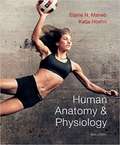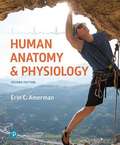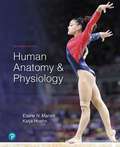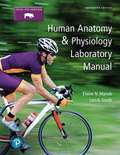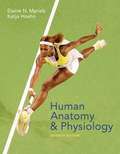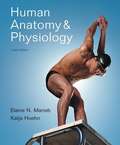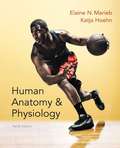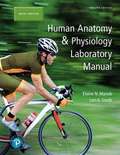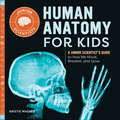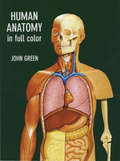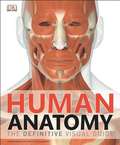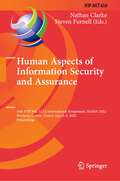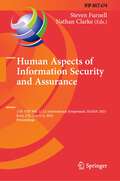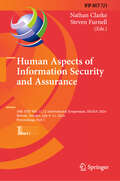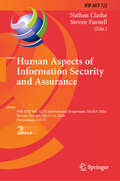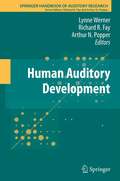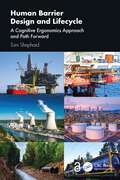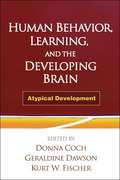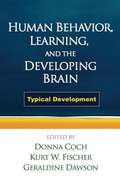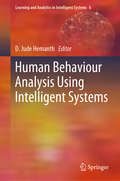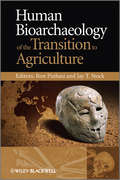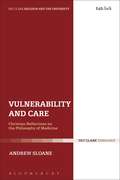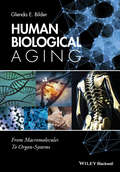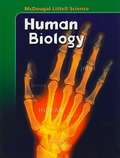- Table View
- List View
Human Anatomy And Physiology
by Elaine N. Marieb Katja N. HoehnNinth Edition of the best-selling Human Anatomy & Physiology, trusted authors Elaine N. Marieb and Katja Hoehn have produced the most accessible, comprehensive, up-to-date and visually stunning anatomy & physiology textbook on the market. Marieb draws on her career as an A&P professor and her experience completing her nursing education; Hoehn relies on her medical education and award-winning classroom instruction—together, they explain anatomy & physiology concepts and processes in a meaningful and memorable way.
Human Anatomy And Physiology
by Erin AmermanHuman Anatomy & Physiology speaks to the way today’s diverse students learn and study. In the 2nd Edition, author Erin Amerman strengthens her distinctive learner-centered approach by focusing on three unique pillars. First, Amerman uses art to present one-concept-at-a-time before bringing the distinct parts together in one summarizing Big Picture figure. Second, Amerman coaches students right when they need it, beginning on page one where the opening module titled How To Succeed in Your Anatomy & Physiology Course appears. And finally, she provides students with ample opportunities to practice and develop critical-thinking skills through questions about case studies and real-world scenarios.
Human Anatomy And Physiology (Eleventh Edition)
by Elaine N. Marieb Katja N. HoehnHuman Anatomy & Physiology has launched the careers of more than three million healthcare professionals. With the newly revised Tenth Edition, Marieb and Hoehn introduce a clear pathway through A&P that helps students and instructors focus on key concepts and make meaningful connections. Each chapter opens with a visual "Chapter Roadmap" that guides students through the material and shows how concepts are related within and across chapters. The new modular organization makes key concepts more readily apparent and understandable to students, and new videos help students see why the content matters in their course as well as their future careers. As students master important concepts and follow a clear path through chapter content, the expanded suite of learning tools in the book and in MasteringA&P ensure they don't get lost along the way.
Human Anatomy And Physiology Laboratory Manual, Fetal Pig Version
by Lori Smith Elaine MariebThe philosophy behind the revision of this manual mirrors that of all earlier editions. It reflects a still developing sensibility for the way teachers teach and students learn, informed by years of teaching the subject and by collecting suggestions from other instructors as well as from students enrolled in multifaceted healthcare programs. Human Anatomy & Physiology Laboratory Manual was originally developed to facilitate and enrich the laboratory experience for both teachers and students. This edition retains those same goals. This manual, intended for students in introductory human anatomy and physiology courses, presents a wide range of laboratory experiences for students concentrating in nursing, physical therapy, pharmacology, respiratory therapy, and exercise science, as well as biology and premedical programs. The manual's coverage is intentionally broad, allowing it to serve both one- and two-semester courses, and it is available in versions that contain detailed guidelines for dissecting a cat or fetal pig laboratory specimen.
Human Anatomy and Physiology (4th edition)
by Elaine N. MariebIn this text Marieb (Holyoke Community College) integrates the relationships of body organ systems, homeostasis, and complementarity of structure and function.
Human Anatomy and Physiology (7th Edition)
by Katja Hoehn Elaine Nicpon MariebWith each edition of her top-selling "Human Anatomy & Physiology" text, Elaine N. Marieb draws on her own, unique experience as a full-time A&P professor and part-time nursing student to explain concepts and processes in a meaningful and memorable way. With the "Seventh Edition," Dr. Marieb has teamed up with co-author Katja Hoehn to produce the most exciting edition yet, with beautifully-enhanced muscle illustrations, updated coverage of factual material and topic boxes, new coverage of high-interest topics such as Botox, designer drugs, and cancer treatment, and a comprehensive instructor and student media package. The Human Body: An Orientation, Chemistry Comes Alive, Cells: The Living Units, Tissue: The Living Fabric, The Integumentary System, Bones and Skeletal Tissues, The Skeleton, Joints, Muscles and Muscle Tissue, The Muscular System, Fundamentals of the Nervous System and Nervous Tissue, The Central Nervous System, The Peripheral Nervous System and Reflex Activity, The Autonomic Nervous System, The Special Senses, The Endocrine System, Blood, The Cardiovascular System: The Heart, The Cardiovascular System: Blood Vessels, The Lymphatic System, The Immune System: Innate and Adaptive Body Defensives, The Respiratory System, The Digestive System, Nutrition, Metabolism, and Body Temperature Regulation, The Urinary System, Fluid, Electrolyte, and Acid-Base Balance, The Reproductive System, Pregnancy and Human Development, Heredity For all readers interested in human anatomy & physiology.
Human Anatomy and Physiology (8th edition)
by Elaine N. Marieb Katja HoehnA modern exploration of the human, from its interacting organ systems to the cellular and molecular underpinnings of the functions of life.
Human Anatomy and Physiology 10th Edition
by Elaine N. Marieb Katja HoehnHuman Anatomy and Physiology is organized under the following units : 1)Organization of the Body 2)Covering, Support, and Movement of the Body 3)Regulation and Integration of the Body and 4) Maintenance of the Body.
Human Anatomy and Physiology Laboratory Manual, Main Version
by Elaine N. Marieb Lori A. SmithFor the two-semester A&P laboratory course. Help manage time and improve learning inside and outside of the lab The #1 best-selling Human Anatomy & Physiology Laboratory Manual helps students and instructors manage time inside and outside of the A&P lab classroom and works hand-in-hand with Mastering A&P, the leading online homework and learning program for A&P. The 13th Edition features dozens of new, full-color figures and photos in the review sheets, as well as revamped clinical application questions and critical thinking questions that reinforce the most important concepts from lab. <P><P>Encourage students to prepare for lab by assigning recommended Mastering A&P activities for each lab exercise, including 18 pre-lab videos (8 are new to this edition), Building Vocabulary Coaching Activities, exercise review sheet assessment questions, art labeling activities, mobile-ready Practice Anatomy Lab™ 3.1 with customizable flashcards, and more. Thousands of assignment options in the Item Library are closely correlated with the print edition of the manual, making it easier than ever to create homework assignments that are aligned with your lab activities.
Human Anatomy for Kids: A Junior Scientist's Guide to How We Move, Breathe, and Grow (Junior Scientists)
by Kristie WagnerLearn what makes our bodies move with the Junior Scientists series for kids ages 6 to 9!Are you curious about what your body looks like under your skin? Do you wonder where your food goes after you eat it? Check out what's happening inside your body with this kid's anatomy book. You'll take a tour of your tissues, organs, muscles, and bones, and find out how they work together to help you move, think, and grow.Explore a kid's anatomy book that includes:Detailed visual guides—Colorful pictures and diagrams show you the names of all your body parts, how your body fights off germs, how snacks become energy, and more.Fun facts—This kid's anatomy book is packed full of fascinating tidbits, like why your body grows hair and what causes freckles.Anatomy in action—Try hands-on activities like pulling the DNA out of strawberries!Discover how your body works with Human Anatomy for Kids.
Human Anatomy in Full Color
by John GreenTwenty-five exceptionally clear and detailed anatomical plates -- with labels and extensive captions -- depict the skeleton, spine, bones, joints, skull, muscles, skin and limbs; heart, stomach, other organs; respiratory, reproductive and digestive systems; development of a fetus and much more. Within reach of grade-school-age children.
Human Anatomy: The Definitive Visual Guide
by Dorling Kindersley Publishing Staff<p>For students of anatomy, biology, and the biomedical sciences; medical professionals; and curious families, DK's Human Anatomy will be a definitive resource. <p>Written by acclaimed anatomist, Dr. Alice Roberts, Human Anatomy is an up-to-the-minute study of the body. Spectacular digital images show the body in incredible, true-to-life detail. Exhaustive annotations provide the names of organs and structures throughout the skeletal, muscular, nervous, cardiovascular, lymphatic, and reproductive systems, while describing their characteristics and functions. <p>This new addition to DK's award-winning catalog of human body titles will help readers better grasp the deep complexities of the human body for research, study, or general reference.</p>
Human Aspects of Information Security and Assurance: 16th IFIP WG 11.12 International Symposium, HAISA 2022, Mytilene, Lesbos, Greece, July 6–8, 2022, Proceedings (IFIP Advances in Information and Communication Technology #658)
by Nathan Clarke Steven FurnellThis book constitutes the proceedings of the 16th IFIP WG 11.12 International Symposium on Human Aspects of Information Security and Assurance, HAISA 2022, held in Mytilene, Lesbos, Greece, in July 2022. The 25 papers presented in this volume were carefully reviewed and selected from 30 submissions. They are organized in the following topical sections: cyber security education and training; cyber security culture; privacy; and cyber security management.
Human Aspects of Information Security and Assurance: 17th IFIP WG 11.12 International Symposium, HAISA 2023, Kent, UK, July 4–6, 2023, Proceedings (IFIP Advances in Information and Communication Technology #674)
by Nathan Clarke Steven FurnellThis book constitutes the proceedings of the 17th IFIP WG 11.12 International Symposium on Human Aspects of Information Security and Assurance, HAISA 2023, held in Kent, United Kingdom, in July 2023. The 37 full papers presented in this volume were carefully reviewed and selected from 54 submissions. They are organized in the following topical sections: education and training; management, policy and skills; evolving threats and attacks; social-technical factors; and research methods.
Human Aspects of Information Security and Assurance: 18th IFIP WG 11.12 International Symposium, HAISA 2024, Skövde, Sweden, July 9–11, 2024, Proceedings, Part I (IFIP Advances in Information and Communication Technology #721)
by Nathan Clarke Steven FurnellThe two-volume set IFIP AICT 721 + 722 constitutes the proceedings of the 18th IFIP WG 11.12 International Symposium on Human Aspects of Information Security and Assurance, HAISA 2024, held in Skövde, Sweden, in July 9–11, 2024. The 39 full papers presented were carefully reviewed and selected from 55 submissions. The papers are organized in the following topical sections: Part I - Management and Risk; Social Engineering; Technical Attacks and Defenses; Usable Security. Part II - Awareness and Education; Privacy.
Human Aspects of Information Security and Assurance: 18th IFIP WG 11.12 International Symposium, HAISA 2024, Skövde, Sweden, July 9–11, 2024, Proceedings, Part II (IFIP Advances in Information and Communication Technology #722)
by Nathan Clarke Steven FurnellThe two-volume set IFIP AICT 721 +722 constitutes the proceedings of the 18th IFIP WG 11.12 International Symposium on Human Aspects of Information Security and Assurance, HAISA 2024, held in Skövde, Sweden, in July 9–11, 2024. The 39 full papers presented were carefully reviewed and selected from 55 submissions. The papers are organized in the following topical sections: Part I - Management and Risk; Social Engineering; Technical Attacks and Defenses; Usable Security. Part II - Awareness and Education; Privacy.
Human Auditory Development
by Arthur N. Popper Richard R. Fay Lynne WernerThis volume will provide an important contemporary reference on hearing development and will lead to new ways of thinking about hearing in children and about remediation for children with hearing loss. Much of the material in this volume will document that a different model of hearing is needed to understand hearing during development. The book is expected to spur research in auditory development and in its application to pediatric audiology.
Human Barrier Design and Lifecycle: A Cognitive Ergonomics Approach and Path Forward
by Tom ShephardA common source of failure in a human‑dependent barrier or safety critical task is a designed‑in mismatch error. The mismatch is a cognitive demand that exceeds the human capability to reliably and promptly respond to that demand given the plausible situations at that moment. Demand situations often include incomplete information, increased time pressures, and challenging environments. This book presents innovative solutions to reveal, prevent, and mitigate these and many other cognitive‑type errors in barriers and safety critical tasks. The comprehensive model and methodologies also provide insight into where and to what extent these barriers and task types may be significantly underspecified and the potential consequences.This title presents a new and comprehensive prototype design and lifecycle model specific to human‑dependent barriers and safety critical tasks. Designed to supplement current practice, the model is fully underpinned by cognitive ergonomics and cognitive science. The book also presents a compelling case for why a new global consensus standard specific to human‑dependent barriers is needed. Taking a novel approach, it presents its suggested basis, framing, and content. Both solutions seek to redress deficiencies in global regulations, standards, and practice. The model is guided by industry recommendations and best practice guidance and solutions from globally recognized experts. Its processes are fully explained and supported by examples, analysis, and well‑researched background materials. Real‑life case studies from offshore oil and gas, chemical manufacturing, transmission pipelines, and product storage provide further insight into how overt and latent design errors contributed to barrier degradation and failure and the consequence of those errors.An essential and fascinating read for professionals, Human Barrier Design and Lifecycle: A Cognitive Ergonomics Approach and Path Forward will appeal to those in the fields of human factors, process and technical safety, functional safety, display and safety system design, risk management, facility engineering, and facility operations and maintenance.Chapters 1 and 8 of this book are freely available as downloadable Open Access PDFs at http://www.taylorfrancis.com under a Creative Commons Attribution-Non Commercial-No Derivatives (CC-BYNC-ND) 4.0 International license.
Human Behavior, Learning, and the Developing Brain
by Geraldine Dawson Donna CochThoroughly examining brain-behavior relationships in atypically developing children, this important volume integrates theories and data from multiple disciplines. Leading authorities present research on specific clinical problems, including autism, Williams syndrome, learning and language disabilities, ADHD, and issues facing infants of diabetic mothers. In addition, the effects of social stress and maltreatment on brain development and behavior are reviewed. Demonstrating the uses of cutting-edge methods from developmental neuroscience, developmental psychology, and cognitive science, the contributors emphasize the implications of their findings for real-world educational and clinical practices. Illustrations include eight pages in full color.
Human Behavior, Learning, and the Developing Brain
by Donna Coch Kurt FischerThis volume brings together leading authorities from multiple disciplines to examine the relationship between brain development and behavior in typically developing children. Presented are innovative cross-sectional and longitudinal studies that shed light on brain-behavior connections in infancy and toddlerhood through adolescence. Chapters explore the complex interplay of neurobiological and environmental influences in the development of memory, language, reading, inhibitory control, and other core aspects of cognitive, emotional, and social functioning. Throughout, the volume gives particular attention to what the research reveals about ways to support learning and healthy development in all children. Illustrations include four pages in full color.
Human Behaviour Analysis Using Intelligent Systems (Learning and Analytics in Intelligent Systems #6)
by D. Jude HemanthHuman–computer interaction (HCI) is one of the most significant areas of computational intelligence. This book focuses on the human emotion analysis aspects of HCI, highlighting innovative methodologies for emotion analysis by machines/computers and their application areas. The methodologies are presented with numerical results to enable researchers to replicate the work. This multidisciplinary book is useful to researchers and academicians, as well as students wanting to pursue a career in computational intelligence. It can also be used as a handbook, reference book, and a textbook for short courses.
Human Bioarchaeology of the Transition to Agriculture
by Jay T. Stock Ron PinhasiA holistic and comprehensive account of the nature of the transition from hunting to farming in prehistory. It addresses for the first time the main bioarchaeological aspects such as changes in mobility, behaviour, diet and population dynamics.This book is of major interest to the relevant audience since it offers for the first time a global perspective on the bioarchaeology of the transition to agriculture. It includes contributions from world-class researchers, with a particular emphasis on advances in methods (e.g. ancient DNA of pathogens, stable isotope analysis, etc.).The book specifically addresses the following aspects associated with the transition to agriculture in various world regions:Changes in adult and subadult stature and subadult growth profilesDiachronic trends in the analysis of functional morphological structures (craniofacial, vault, lower limbs, etc.) and whether these are associated with change in overall sex-specific morphological variabilityChanges in mobilityChanges in behaviour which can be reconstructed from the study of the skeletal record. These include changes in activity patterns, sexual dimorphism, evidence of inter-personal trauma, and the like. Population dynamics and microevolution by examining intra and inter population variations in dental and cranial metric traits, as well as archaeogenetic studies of ancient DNA (e.g. mtDNA markers).
Human Biodiversity: Genes, Race, and History
by Jonathan MarksAre humans unique? This simple question, at the very heart of the hybrid field of biological anthropology, poses one of the false of dichotomies--with a stereotypical humanist answering in the affirmative and a stereotypical scientist answering in the negative. The study of human biology is different from the study of the biology of other species. In the simplest terms, people's lives and welfare may depend upon it, in a sense that they may not depend on the study of other scientific subjects. Where science is used to validate ideas--four out of five scientists preferring a brand of cigarettes or toothpaste--there is a tendency to accept the judgment as authoritative without asking the kinds of questions we might ask of other citizens' pronouncements. In Human Biodiversity, Marks has attempted to distill from a centuries-long debate what has been learned and remains to be learned about the biological differences within and among human groups. His is the first such attempt by an anthropologist in years, for genetics has undermined the fundamental assumptions of racial taxonomy. The history of those assumptions from Linnaeus to the recent past--the history of other, more useful assumptions that derive from Buffon and have reemerged to account for genetic variation--are the poles of Marks's exploration.
Human Biological Aging
by Glenda E. BilderComprehension of the theories of aging requires rudimentary knowledge of oxidation and reduction reactions, protein function, cell organelles, mitosis, acquired immunity, and evolution, among other basic biological concepts. Without these fundamentals, students of biological aging struggle to learn the essentials of biological aging and how to appreciate the research advances in the field. Human Biological Aging: From Macromolecules To Organ-Systems is an introduction to human aging from the level of macromolecules to organ systems. Age changes in proteins, DNA, polysaccharides and lipids are discussed relative to known age-related alterations in structure and function produced by free radicals and oxidants. At the cellular level, age-dependent mechanisms that diminish organelle function are described. Cellular phenomena of replicative senescence apoptosis, autophagy and neuroplasticity are detailed as to their contribution to compromised cellular functions. Authored by a leader in the field, Human Biological Aging: From Macromolecules To Organ-Systems is an invaluable introduction for those studying human aging.
